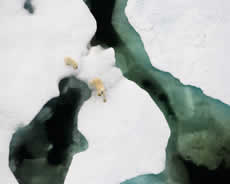Sea Ice: The Dynamic Center of the Arctic World
Sea ice may freeze as flat as liquid water, but it is soon broken, stacked, and twisted by the immense forces of currents, wind, and atmospheric pressure acting across floes the size of states…. – Charles Wohlforth, author
Arctic sea ice is constantly changing—grinding, fracturing, colliding, building, and eroding—like a fast-motion version of the Earth's geology. There are two types of sea ice: annual ice and multiyear ice. The Arctic web of life depends on the annual cycle of changing ice conditions.
Annual ice forms in late autumn along the coast over the shallow, biologically productive waters of the continental shelf. It is easily penetrated by sunlight and is the foundation of life on and under the ice. Annual ice thins and cracks in spring, producing narrow, shifting channels of water called leads. Whales, seals, and other marine animals navigate through the ice via these "water highways." Annual ice melts completely in summer and then expands in the fall, becoming landfast (attached to the land) once again.
Multiyear ice lies over the central basin of the Arctic Ocean. The extent of this thicker ice shrinks in the summer and increases again in the winter. |

Sow with cub walking on multi-layer ice (Chukchi Sea, Alaska)
Photograph by Steven Kazlowski
|

